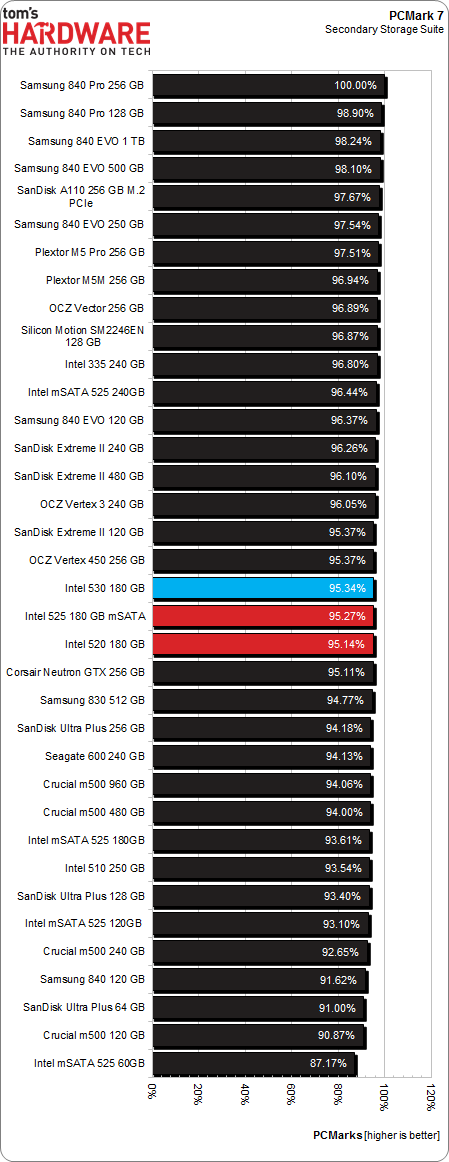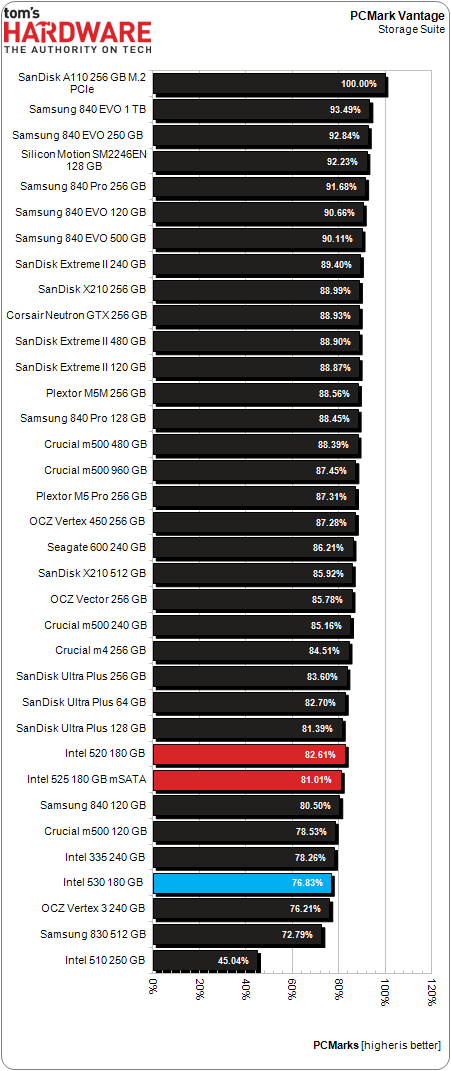Intel SSD 530 Review: A Revised Controller And 20 nm Flash
Intel recently lifted the veil on a replacement for its SSD 520, not surprisingly called the SSD 530. It partners new SandForce silicon with IMFT's 20 nm flash for better power consumption and a more modest price tag. Does the evolution pay off?
Results: PCMark Vantage And PCMark 7
Futuremark's PCMark 7: Secondary Storage Suite
PCMark 7 uses the same trace-based technology as our Storage Bench v1.0 for its storage suite testing. It employs a geometric mean scoring system to generate a composite, so we end up with PCMarks instead of a megabytes per second. One-thousand points separate the top and bottom, but that encompasses a far larger difference than the score alone indicates.
This test is a big improvement over the older PCMark Vantage, at least for SSD benchmarking. The storage suite is comprised of several small traces. At the end, the geometric mean of those scores is scaled with a number representing the test system's speed. The scores generated are much different from PCMark Vantage, and many manufacturers are predisposed to dislike it for that reason. It's hard to figure out how PCMark 7 "works" because it uses a sliding scale to generate scores. Still, it represents one of the best canned benchmarks for storage, and if nothing else, it helps reinforce the idea that the differences in modern SSD performance don't necessarily amount to a better user experience in average consumer workloads.
In a reversal of the previous page, Intel's SSD 530 outpaces the 520 and 525, though the margin is as slim as can be.
We're including a bit more information in this review. Not only do you get the raw scores in PCMarks, but we also calculate percentages relative to the fastest finisher (in this case, Samsung's 840 Pro 256 GB). The SSD 530 achieves 95.34% of the first-place drive's score, while the SSD 520 and 525 earn 95.27% and 95.14%, respectively. Those are solid outcomes across the board.
Futuremark's PCMark Vantage: Hard Drive Suite
PCMark's Vantage isn't the paragon of SSD testing, mainly because it's old and wasn't designed for the massive performance solid-state technology enables. Intended to exploit the new features in Windows Vista, Vantage was certainly at the forefront of consumer storage benching at the time. Vantage works by taking the geometric mean of composite storage scores and then scaling them a lot like PCMark 7 does. But in Vantage's case, this scaling is achieved by arbitrarily multiplying the geometric sub-score mean by 214.65. That scaling factor is supposed to represent an average test system of the day (a system that's now close to a decade behind the times). PCMark 7 improves on this by creating a unique system-dependent scaling factor and newer trace technology.
Get Tom's Hardware's best news and in-depth reviews, straight to your inbox.
Why bother including this metric, then? A lot of folks prefer Vantage in spite of or because of the cartoonish scores and widespread adoption. That, and the fact that most every manufacturer uses the aged benchmark in box specs and reviewer-specific guidelines. In fairness, Vantage's Hard Drive suite wasn't designed with SSDs in mind, and is actually quite good as pointing out which 5400 RPM mechanical disk might be preferable.
Intel's SSD 510 at 250 GB manages just 45.04% of the SanDisk A110's finish. That makes the trio of more modern 180 GB Intel drives look brilliant by comparison, though the SSD 530 does trail the SSD 520 and 525, based on SandForce's earlier-revision controller.
Current page: Results: PCMark Vantage And PCMark 7
Prev Page Results: Tom's Hardware Storage Bench, Continued Next Page Results: File Copy Performance With Robocopy
